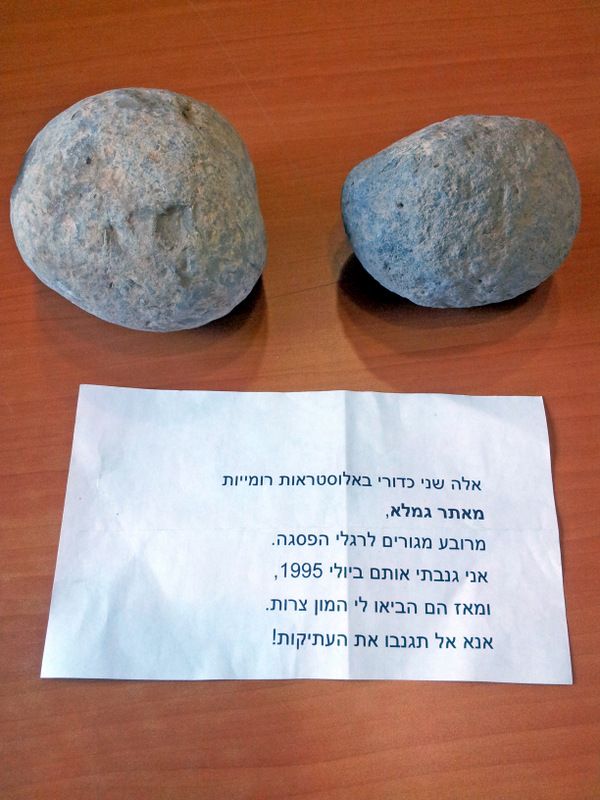'Cursed' Artifacts Returned — 20 Years Later

Two decades after stealing antiquities from a first-century Jewish city in the Golan Heights, on the borders of Israel and Syria, a robber returned the loot to a museum's courtyard, Israeli authorities announced.
The returned artifacts included two 2,000-year-old sling stones, also called ballista balls, which would've been used as weapons, and an anonymous typed noted saying, "These are two Roman ballista balls from Gamla, from a residential quarter at the foot of the summit. I stole them in July 1995, and since then they have brought me nothing but trouble. Please, do not steal antiquities!"
Although archaeologists "attempted to stow away all the ballista balls as best we could," on site, after wrapping up initial excavations in 1989, "the theft occurred in 1995 when there was no one at the site," Danny Syon an archaeologist with the Israel Antiquities Authority (IAA) said in a statement. "We did not realize that something was missing, Syon said. [The Holy Land: 7 Amazing Archaeological Finds in Israel]
The stolen artillery stones were dropped off in a bag at the Museum of Islamic and Near Eastern Cultures in Be'er Sheva, and will soon join their fellow ballista balls in the National Treasures Department of the IAA. Other ballista balls from the same time are on display at the Gamla Nature Reserve, a national park in the central Golan Heights that hosts the remains of Gamla.
An ancient city with a tumultuous past
Gamla is an ancient walled city built on a steep hill resembling a camel's hump on the southern tip of the Golan Heights. (The name "gamla" derives from the Hebrew word for "camel.")
Romans chiseled and launched the ballista balls to siege Gamla at the beginning of the Great Revolt, also known as the First Jewish-Roman War, from A.D. 66 to 73, which was the first of three major rebellions by the Jewish people against the occupying Roman Empire.
Sign up for the Live Science daily newsletter now
Get the world’s most fascinating discoveries delivered straight to your inbox.
"Almost 2,000 such stones were found during the archaeological excavations in the Gamla Nature Reserve, and this is the site where there is the largest number of ballista stones from the Early Roman period," Syon said in a statement. "The Romans shot these stones at the defenders of the city in order to keep them away from the wall, and in that way they could approach the wall and break it with a battering ram."
The Romano-Jewish historian Flavius Josephus wrote the first-known account of the Roman siege of Jerusalem, describing the Roman general Vespasian, who marched north from Galilee in northern Israel to subdue the town of Gamla at the beginning of the Great Revolt.
Josephus recalled Jewish history and the Jewish revolt against the Romans in his first-century books "The Jewish War" and "Antiquities of the Jews." Some archaeologists have used his texts to help interpret their findings.
After several months and several ballista balls, the Romans overcame the walls of Gamla and forged ahead into the city. Josephus wrote that the 9,000 remaining residents fought their way to the edge of their town and jumped to their deaths into the gorge below when they realized they couldn't escape capture — the site's nickname is "the Masada of the north." According to Josephus, the Masada, an ancient fortification in southern Israel overlooking the Dead Sea, was the site of a mass suicide of just under a 1,000 Jewish rebels during the Great Revolt.
Previous returns
The return of the ballista balls, two millennia after they were used in the Roman siege, was not particularly shocking, said Syon. "Such 'returns' are not that extraordinary," Syon said. "They happen every few years," and typically include "small pottery fragments and conscience pangs," Syon told Live Science in an email.
A Tel Aviv resident held onto a 2,000-year-old Jewish coffin until, he said, he realized what it was and returned it to the Unit for Prevention of Antiquities Robbery, which sent it to the IAA, Syon said. In another incident, a minister from New York expressed remorse over the decade-old action of a member of his congregation, who had stolen a stone from Jerusalem. The stone ended up back with the IAA, according to the organization.
On a grander scale, U.S. authorities confiscated over 60 stolen artifacts during "Operation Lost Treasure," which aimed to disrupt antiquities-trafficking networks and return artifacts to their rightful countries. The artifacts, including gold-plated items from Saddam Hussein's palace, were intercepted as they traveled from Iraq to the United States.
Elizabeth Goldbaum is on Twitter. Follow Live Science @livescience, Facebook & Google+. Original article on Live Science

Most Popular




